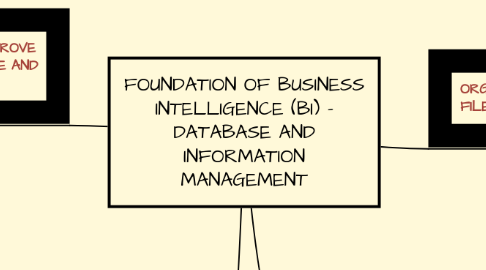
1. USING DATABASE TO IMPROVE BUSINESS PERFORMANCE AND DECISION MAKING
1.1. Big Data
1.1.1. Definiton
1.1.1.1. Data set with high volume
1.1.2. Refers to
1.1.2.1. Petabytes
1.1.2.2. Exabytes
1.1.3. To business
1.1.3.1. Reveal more pattern
1.1.3.2. Interesting and anomalies
1.2. BI infrastruture
1.2.1. Functon
1.2.1.1. Tools to separate system and big data
1.2.2. Tools
1.2.2.1. Data warehouse
1.2.2.2. Data marts
1.2.2.3. Hadoop
1.2.2.4. in memory computing
1.2.2.5. Analytical problem
1.3. Analytical tools
1.3.1. Relationship
1.3.2. Pattern
1.3.3. Trend
1.4. Database and the web
1.4.1. Typical configuration
1.4.1.1. Web server
1.4.1.2. Database server
1.4.1.3. Application server
1.4.2. Advantages
1.4.2.1. Ease of use browser software
1.4.2.2. inexpensive
2. MANAGING DATA RESOURCE
2.1. Establishing an information policy
2.1.1. Organization rules
2.1.2. Procedures and accountabilities
2.2. Ensuring data quality
2.2.1. Avoid problems
2.2.2. Identify better routine
2.2.3. Identify and correct faulty data
3. ORGANIZING DATA IN A TRADITIONAL FILE ENVIRONMENT
3.1. File organization terms and concept
3.1.1. Concept
3.1.1.1. Databae
3.1.1.2. File
3.1.1.3. Record
3.1.2. Terms
3.1.2.1. Field
3.1.2.2. Byte
3.1.2.3. Bit
3.2. Problems
3.2.1. Data redundancy
3.2.2. Data Inconsistent
3.2.3. Program Data-depende
3.2.4. Lack of flexibility
3.2.5. Poor security
3.2.6. Lack of data sharing and avaibility

